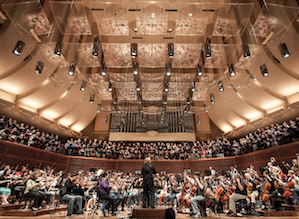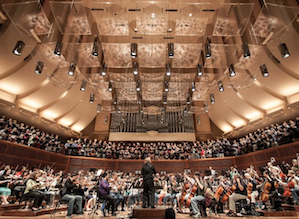
The Redwood Symphony played a hefty program Saturday night at Cañada College in front of a full house. The concert featured two overtures: Nicolai Rimsky-Korsakov’s festive Dance of the Tumblers and Raymond Scott’s brash Powerhouse. Mozart’s noble Piano Concerto No. 23, in A Major, rounded out the first half. After intermission, the orchestra tackled Gustav Host’s epic masterpiece The Planets in an impressive interpretation.
The program booklet listed 37 violins, 12 violas, 13 cellos, and 7 basses — way more strings than even some top orchestras can afford. The large numbers created a powerful intensity, but after a certain point the story was no longer about the numbers than it was about cohesive ensemble and volume. The fast sections in some pieces were a jumble, and the brass, despite their numbers, still drowned out other sections in climaxes. In this hectic music, nevertheless, was felt a spirit of playing music for the love of it. Listeners witnessed a huge amateur orchestra struggling mightily to synchronize hundreds of instruments’ harmony and intricate rhythmic patterns in real time. It’s so difficult to do, that whenever it happens it counts as a minor miracle of humanity.
These numbers, in my view, are more about people’s desire (both players and listeners) to connect into a collective so tightly knit that they breathe and even tap their fingertips together, yearning to make music rather than just consume it. It is impossible to do anything but commend community orchestras like this that are full of people who make time in their busy lives for practice, rehearsal, and performance. Thus, it was heart-warming to see a wide variety of ages and skill levels on stage, being given a warm reception by family, friends, and community members in the audience, including a good number of well-behaved children.
The eerie, amplified voices cast an enigmatic spell as the lights dimmed to black and the orchestra faded to silence.
I have heard community orchestras give cringe-worthy performances, but the Redwood Symphony has almost arrived at the level of a professional orchestra. Music Director Eric Kujawsky evidently feels that he can challenge his players with difficult pieces from the orchestral repertoire.
As his guest artist, Jeffrey Jones channeled neoclassical emotional restraint in the Mozart piano concerto. He played with elegant phrasing and a smooth, delicate tone. This made for a rather stoic reading, however, that at times sounded a bit timid. Mozart is one of the hardest composers to pull off, given the smaller group used, highly exposed orchestration, and the need for careful phrase endings. Everyone needs to stop whacking bows and batons at the end of phrases in Mozart. Fortunately, Kujawsky leads his orchestra with a firm technique, giving clear and cheerful cues, and even choosing tempos on the slow side. He could perhaps attempt to taper phrases more carefully, though.
Luckily for us, community orchestras provide an opportunity for musicians at all levels and of all professions to experience symphonic masterpieces from the inside.
In Holst’s Planets, the orchestra created distinct sound worlds in each movement. The piece is really more about the mythological characters after which the planets are named than about astronomy. Nonetheless, the titles, combined with the music, really ignite the imagination in a musical tour of the solar system. The Martian march was intense, and the glorious theme from Jupiter was truly exhilarating. Some very effective harp playing was heard throughout. For the last movement, “Neptune the Mystic,” some members of the orchestra went back stage to sing “oohs” in a distant choir. The eerie, amplified voices cast an enigmatic spell as the lights dimmed to black and the orchestra faded to silence — in effect, faded into the void of unknown space.
Around the Bay Area, participants in youth orchestras must number well into the thousands. Yet so often, after graduating from high school or (in better cases) after college, students’ instruments rest forgotten in a closet somewhere, gathering dust as life and careers take over. Music requires constant practice; you use it or you lose it. Luckily for us, community orchestras provide an opportunity for musicians at all levels and of all professions to experience symphonic masterpieces from the inside. The Redwood Symphony, therefore, stands as an important cultural asset for the Peninsula.

